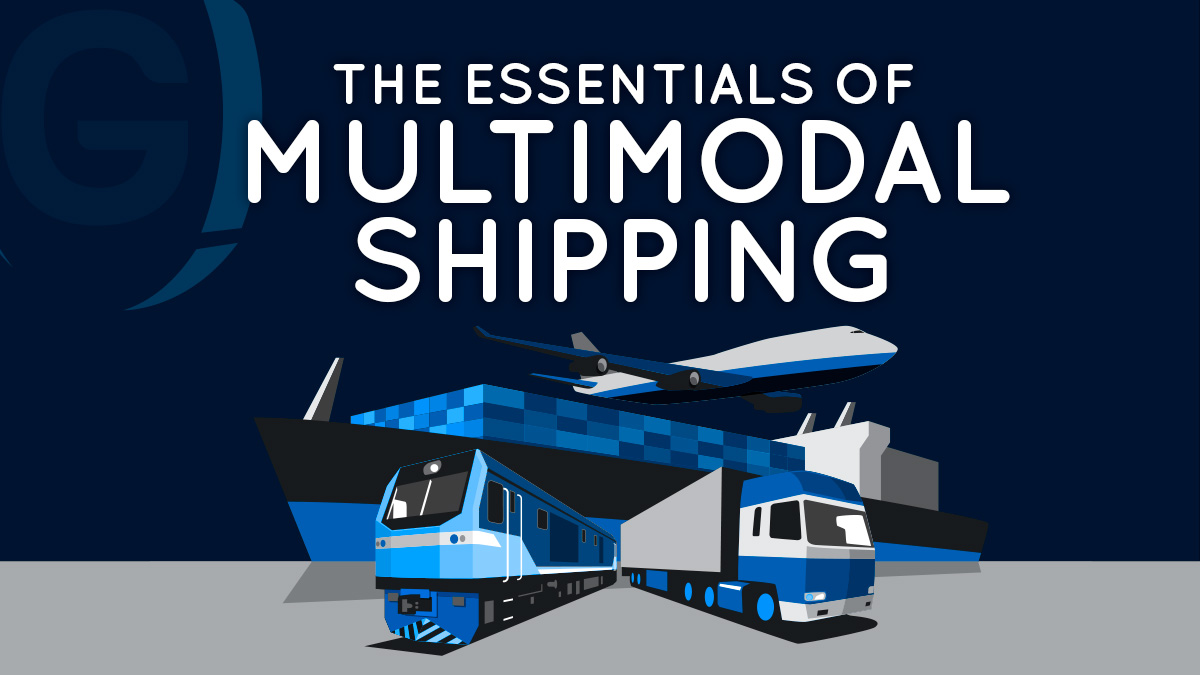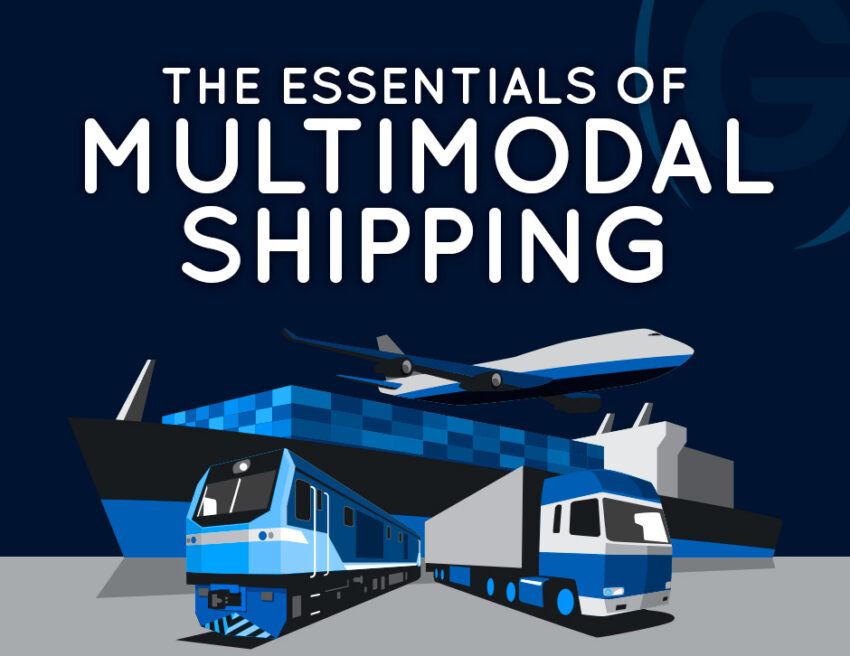In the world of freight forwarding, few things are as complex—or as critical—as getting goods from point A to point B. Imagine coordinating a shipment that starts in a factory in China, travels by truck to the port, ships across the ocean, and then moves by rail across the U.S. to reach its final destination. This process, known as multimodal shipping, requires seamless coordination across different transportation modes. Freight forwarding companies have become experts at managing these logistics puzzles, ensuring that goods move efficiently, on time, and in compliance with various regulations.
Multimodal shipping isn’t just about moving goods; it’s about finding the best way to do it. With global trade projected to reach over $32 trillion by 2030, according to the World Trade Organization, freight forwarding companies are more essential than ever in maintaining a streamlined and cost-effective supply chain. Here, we’ll dive into the essentials of multimodal shipping, explore its benefits, and discuss how freight forwarders can navigate its complexities to best serve their clients.

What is Multimodal Shipping?
Multimodal shipping refers to the transportation of goods under a single contract but using two or more different modes of transportation, such as rail, road, sea, or air. In multimodal shipping, the forwarder takes on the responsibility for the entire journey from start to finish, including any transfers between modes. This differs from intermodal shipping, where each leg of the journey is covered by a separate contract.
For freight forwarders, multimodal shipping simplifies logistics and offers flexibility. By having a single contract that oversees all aspects of the shipment, forwarders can streamline processes and improve efficiency. Additionally, by leveraging multiple modes, freight forwarders can optimize routes, cut costs, and reduce transit times, which benefits their clients directly.
The Growing Importance of Multimodal Shipping for Freight Forwarding Companies
As global trade intensifies, multimodal shipping has become a vital tool for handling the vast quantity of goods moving around the world. In 2023 alone, over 11 billion tons of cargo were moved across the globe, with multimodal transportation handling a significant portion of these shipments. This demand is only expected to increase as e-commerce continues to boom and consumers expect faster delivery times.
With its flexibility, multimodal shipping offers a solution to the ever-growing complexity of supply chains. Today’s customers want their goods delivered faster, at lower costs, and with minimal environmental impact. Multimodal shipping offers freight forwarders the ability to manage these demands by using the most efficient combination of transportation methods available.
Benefits of Multimodal Shipping for Freight Forwarding Companies
1. Cost Efficiency:
One of the primary benefits of multimodal shipping is cost efficiency. By combining modes of transportation, forwarders can select the best options to fit both the budget and timeline. For instance, moving goods from Asia to Europe by sea is cheaper than air freight, but switching to rail or truck for the last leg allows them to reach landlocked destinations faster and at a lower cost. This flexibility enables forwarders to offer their clients competitive rates without compromising on service quality.
2. Improved Transit Times:
Multimodal shipping provides an advantage in terms of transit time. By selecting the most efficient mode for each part of the journey, freight forwarders can reduce delays and ensure that goods arrive on time. In an industry where every hour counts, minimizing transit time is crucial. For instance, a combination of air and road transport can cut transit time drastically compared to sea transport alone, helping companies meet tight delivery schedules.
3. Enhanced Environmental Sustainability:
Multimodal shipping can also help reduce a shipment’s carbon footprint. By choosing more environmentally friendly transport options—such as rail instead of road for long-distance inland travel—forwarders can help minimize greenhouse gas emissions. Given the growing demand from customers and governments alike for sustainable practices, this approach helps companies align with global sustainability goals and make a positive impact.
4. Reduced Risk and Increased Security:
By using multimodal transport under a single bill of lading, forwarders can reduce the risk associated with multiple contracts and liabilities. This simplifies documentation and ensures that forwarders maintain full control and visibility over the entire shipping process. Moreover, when goods are transferred seamlessly from one mode to another, there is less risk of theft or damage, as they spend less time exposed during transit.
Challenges of Multimodal Shipping
While multimodal shipping offers significant advantages, it also comes with challenges. Freight forwarders must navigate complex regulations, handle the intricacies of coordinating different transportation modes, and manage potential delays due to unforeseen circumstances like weather or customs issues.
1. Regulatory Complexity:
Each mode of transportation comes with its own set of regulations, which can vary from country to country. For instance, the documentation required for sea freight differs significantly from what’s needed for air cargo. Forwarders must stay informed about these regulations and ensure compliance to avoid delays, fines, or legal complications. Working with experienced partners and leveraging digital tools for tracking and documentation can ease this burden.
2. Logistical Coordination:
Coordinating multiple transportation modes means working with various carriers, schedules, and requirements. This can make the process complex and time-sensitive. For example, if a shipment is delayed at one stage, it can disrupt the entire schedule. Freight forwarders must have contingency plans in place and rely on their network to quickly address such issues.
3. Potential for Delays:
The more modes of transport involved, the higher the chances of delays. Bad weather, port congestion, or customs clearance delays can all impact the smooth flow of goods. For this reason, real-time tracking and communication with clients are essential to managing expectations and minimizing disruptions.
Leveraging Technology in Multimodal Shipping
Technology plays an essential role in multimodal shipping. With advances in logistics software, freight forwarders can now track and manage shipments in real-time, ensuring greater visibility throughout the journey. From GPS tracking to AI-powered route optimization, these tools help forwarders make data-driven decisions, reduce delays, and enhance customer satisfaction.
Blockchain is also making inroads into multimodal shipping by creating a secure, transparent way to manage contracts, track shipments, and streamline documentation. By using blockchain-based digital records, forwarders can ensure accuracy and build trust with clients by providing verified, real-time updates on their cargo’s status.
Future Trends in Multimodal Shipping
Looking forward, the importance of multimodal shipping is set to increase. Trends such as sustainability, e-commerce growth, and the push for faster delivery times are all driving innovation in this area. Forwarders are likely to see more investment in infrastructure, such as better rail connections and more efficient ports, to facilitate the smooth transfer of goods across different modes.
Furthermore, as technology advances, we can expect to see more sophisticated logistics tools that make it easier to plan, track, and manage multimodal shipments. Artificial intelligence and machine learning, for instance, are beginning to predict transit times with higher accuracy, enabling better planning and fewer delays.
Conclusion
Multimodal shipping is essential for freight forwarding companies navigating the complexities of today’s global trade environment. By combining flexibility, efficiency, and sustainability, it allows forwarders to offer comprehensive solutions that meet the demands of modern commerce. Although multimodal shipping presents challenges, from regulatory hurdles to logistical coordination, its benefits far outweigh the obstacles.
With technology continuously advancing and the demand for sustainable practices growing, multimodal shipping will remain a cornerstone of freight forwarding. By embracing these evolving strategies and leveraging technological tools, freight forwarders can continue to thrive in a rapidly changing industry, helping clients achieve seamless, efficient, and cost-effective logistics solutions in a global marketplace,


